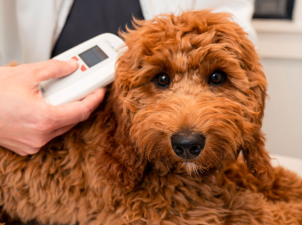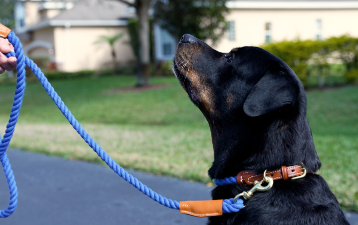For years, pet owners and breeders have relied on tattoos as a more permanent form of pet identification, since collar tags can be easily lost or removed. Unfortunately, using tattoos is not a foolproof method. Let's say your dog is lost. Someone finds him and takes him to an animal shelter. Once there, he is uneasy and possibly scared. The shelter worker quickly notices a rough metal ring hanging from his collar, where his ID tag is hanging. When she tries to check your dog for tattoos, he growls and squirms. His hair is matted, and the assistant can't see a string of numbers near his right hind leg. This situation is not uncommon, so people have been trying to find other identification systems. One of the newest and most popular systems is the microchip.


For years, pet owners and breeders have relied on tattoos as a more permanent form of pet identification, since collar tags can be easily lost or removed. Unfortunately, using tattoos is not a foolproof method. Let's say your dog is lost. Someone finds him and takes him to an animal shelter. Once there, he is uneasy and possibly scared. The shelter worker quickly notices a rough metal ring hanging from his collar, where his ID tag is hanging. When she tries to check your dog for tattoos, he growls and squirms. His hair is matted, and the assistant can't see a string of numbers near his right hind leg. This situation is not uncommon, so people have been trying to find other identification systems. One of the newest and most popular systems is the microchip.

Where is the microchip implanted?
Although it is a microchip implanted in a dog, where and how is the microchip implanted?
If it is a dog, the microchip is generally implanted in the back of the neck (behind the neck) and is implanted in the body using a special injection needle that is slightly thicker than the normal injection needle. The size of a microchip is 2m in diameter x 8-12mm in length. It can be implanted without sedatives or anesthetics. However, in order to prevent the dog from feeling pain and making a fuss, it is sometimes implanted during anesthesia such as contraception or sterilization. Generally, there are few cases where a microchip implanted in the body moves inside the body.
Benefits of microchip implantation
A microchip for a dog can prove the dog's identity. The biggest benefit of implanting a microchip in a dog is that it can accurately and reliably prove the dog's identity.
Even if the dog leaves its owner due to disasters such as earthquakes and floods, or due to theft, accidents, or getting lost, if a microchip is implanted, the dog is likely to return to its owner again. Things that can prove the dog's identity include microchips, lost cards, collars, etc. However, there is a possibility that the card and collar will fall off when the dog gets lost. In contrast, because the microchip is embedded in the body and does not fall off, it can more reliably prove the identity.

What is the use of a microchip implanted in a dog's body?
One of the methods of proving the dog's identity is to use a microchip. The dog's microchip records a unique number (15 digits) in the world. If you embed it in the dog's body and read it with a dedicated reader, you can identify each of their information. Since the reader is installed in animal protection centers, adoption centers, pet hospitals, etc. across the country, it can be read at these facilities.
Once the microchip is embedded in the body, it will hardly fall off or disappear, and the data will not be rewritten. For this reason, it was first used in Europe and the United States as a safe and reliable identification method, and is now widely used around the world. In addition, since the dog's microchip does not have a GPS function, even if it is embedded in the microchip, the dog cannot know the dog's activity trajectory, but with the current technology becoming more and more advanced, it is only a matter of time before the GPS function is implanted.



